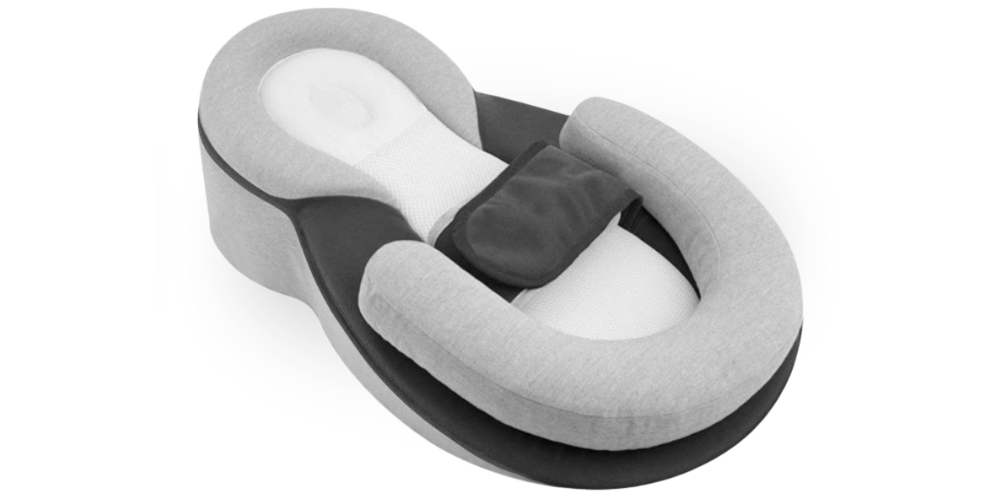When your baby is crying in pain after every feed, spits up constantly, and refuses to sleep flat, you’ll do whatever it takes to help them feel better. If you’ve spent late nights scrolling through forums, Facebook groups, or TikTok hacks, you’re far from alone.
The problem? A lot of the advice out there is confusing, outdated, or even unsafe.
Let’s break down the 5 most common mistakes parents make when trying to relieve baby reflux — and what you can safely do instead to bring real comfort and better sleep.
Note: This article provides general information only and should not replace professional medical advice.
Mistake 1: Laying Baby Flat Right After Feeding
Many parents finish a feed, burp once (or not at all), and lay their baby flat in the crib — hoping for a nap.
But when your baby lies flat too soon after feeding, gravity no longer helps keep milk in the stomach. That means more spit-ups, discomfort, and wake-ups.
✅ What to do instead:
Hold your baby upright for 20–30 minutes after every feed. Gentle cuddles, slow walking, or rocking while upright can make a huge difference in comfort.
Mistake 2: Overfeeding to “Help Them Sleep Longer”
It’s a common belief: if I give my baby more milk before bed, they’ll sleep through the night.
But in reflux babies, overfilling the stomach increases pressure, which leads to more spit-up, pain, and shorter sleep stretches — not longer ones.
✅ What to do instead:
Feed smaller, more frequent amounts. Focus on quality over quantity. A calm baby with less discomfort is far more likely to sleep longer than an overfed, uncomfortable one.
Mistake 3: DIY Inclines or Unsafe Positioners
A towel under the mattress. A random wedge from Amazon. A viral hack you saw on TikTok.
These may seem harmless, but they can create unsafe sleep angles, gaps, or soft surfaces that increase suffocation risk.
✅ What to do instead:
If you use an incline, make sure it’s designed and tested specifically for infants. Products like DreamNest™ offer a pediatric-recommended 15° incline, anti-roll barriers, and breathable materials — helping babies sleep more comfortably without compromising safety.
👉 Discover DreamNest™ — trusted by thousands of parents for safer, more restful nights.
Mistake 4: Ignoring Feeding Techniques
Reflux isn’t just about sleep — it often starts with feeding. Fast feeding, skipping burps, or using the wrong bottle flow can all make reflux worse.
✅ What to do instead:
-
Feed in a calm, upright position.
-
Burp halfway through and after each feed.
-
Use slower-flow nipples to reduce air swallowing.
-
Avoid pressure on the tummy during and after feeds.
These small tweaks can prevent discomfort from starting in the first place.
Mistake 5: Assuming All Reflux Is the Same
Not all reflux is created equal.
Some babies only spit up a little and are perfectly content. Others show signs of pain, arch their backs, or struggle to sleep. And in some cases, it may be gastroesophageal reflux disease (GERD), which needs medical attention.
✅ What to do instead:
Watch your baby’s overall behavior. If you notice persistent crying, poor weight gain, trouble breathing, or projectile vomiting, talk to your pediatrician. Getting clarity will save you weeks of frustration — and get your baby the right support.
Bonus: The Power of the Right Sleep Setup
When you address reflux from both sides — feeding habits and sleep environment — the results can be life-changing for both baby and parent.
That’s why more and more families turn to ergonomic sleep solutions like DreamNest™.
Developed by pediatric osteopaths, it offers gentle incline, breathable fabrics, and secure anti-roll safety — everything needed to support better digestion and longer stretches of sleep.
👉 Try DreamNest™ risk-free for 90 nights — and finally wake up rested.
FAQs
Does elevating my baby’s mattress help reflux?
Only if done safely with a tested ergonomic incline product. DIY hacks can be dangerous.
Why is my baby’s reflux worse at night?
Lying flat slows digestion and allows milk to flow back more easily. A gentle incline can help.
Will my baby outgrow reflux?
Most babies outgrow reflux between 4 and 12 months as their digestive system matures.
Can feeding changes really make a difference?
Yes — feeding calmly, burping often, and using slow-flow nipples can reduce discomfort significantly.
Should I talk to a doctor?
Yes, if your baby shows signs of pain, poor weight gain, or severe symptoms.
Conclusion: A Little Knowledge Goes a Long Way
Reflux can make you feel helpless — but many sleepless nights come down to a few common mistakes.
By changing feeding habits, using only safe sleep aids, and following expert-backed tips, you can ease your baby’s discomfort and finally reclaim your nights.
You’re not failing. You’re learning. And your baby will feel the difference. 🌙



